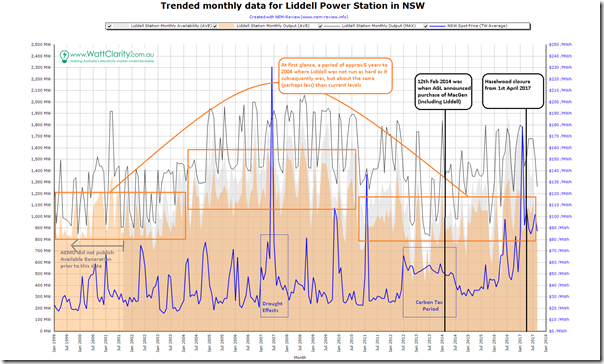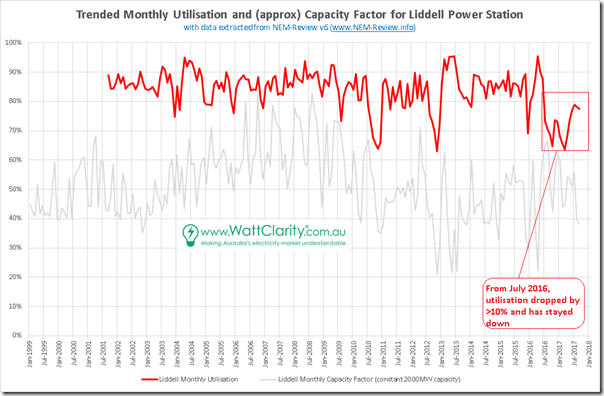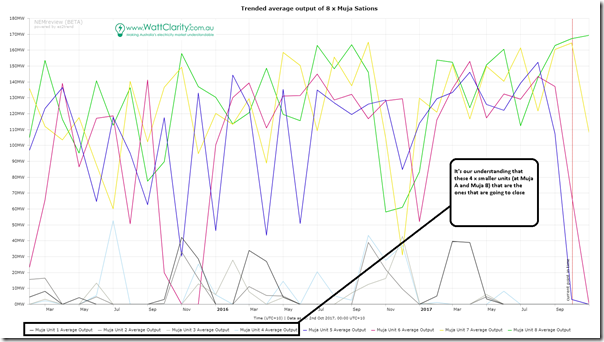I’ve seen and heard this comparison made by others in the past month or two, given all the brouhaha about “will it, or won’t it – should it, or shouldn’t it” close with respect to Liddell Power Station.
Given that we’re starting to increase the attention we place on the South-Western Interconnected System (SWIS) of Western Australia, I’ve had a preliminary look at what we might see in some data, by way of comparison:
1) What we can see in the data for Liddell Power Station
One of the common comments in the media has been that Liddell has not been operating as heavily in recent times – due to a combination of different factors (including technical issues with an ageing plant, higher cost impacts, and more recently the availability of sufficient coal).
Being part of the NEM, we’ve been working with data for Liddell Power Station since we began operations in 2000.
Powering up NEM-Review v6, I’ve produced the following longer-run trend of Liddell total output for each month since January 1999, and included a couple particular notes:
There’s two things I’d like to highlight here:
1a) I’ve highlighted on the chart a period of the “middle years” when output at Liddell increased:
(i) but that this dropped back to prior levels from around 2010 – with the decline in demand seen across the NEM from around that time presumably being one of the factors;
(ii) from mid 2016 we see the pattern of output increase slightly;
1b) To the extent that AEMO published station available generation data, we have seen a consistent pattern through all the years where Liddell has run at reasonably steady Monthly Utilisation (note, for the casual reader, that this measure is not the same as capacity factor, which has clearly varied more significantly):
(i) This can be seen clearly in the following trended utilisation factor, which shows operation in a fairly tight band between 80% and 90% over the majority of months since data is first available (Sept 2001) – but that this has dropped by more than 10% from July 2016 and stayed down for 15 months:
(ii) In layman’s terms, it means that the station was run fairly consistently to the extent it was available up until July 2016 – where we can see (in the first chart) that the availability stepped up, but that this was not followed by as big an increase in output.
2) What we can see in the data we have for Muja Power Station
As part of the development of the upgraded NEMreview v7, we’re adding in a diverse range of additional data sets – including data for the South-West Interconnected System as noted here. Being a data junkie, and curious about the comparisons that have been made between Liddell and Muja, I had a quick look to see what could be seen:
Unfortunately, the data we currently have available for use in NEMreview v7 only extends back to February 2015 (I have not checked but believe that’s probably a result of when we started development work to add aggregate WA data into the NEM-Watch Fuel Type Widget). We are in the process of sourcing earlier data in order that we can fill out the record available for our NEMreview clients.
Despite the relative lack of data, what the chart does show, however, is that:
2a) The four units from A and B station at Muja hare much smaller than the 4 units at Liddell (though the SWIS is also a smaller grid); and
2b) There are many months (in the 32 month range shown) where these older units have not run at all. Clearly Liddell is not in this position currently.
It might be worth clarifying (in this excerpt lifted from our 2014 Issue “Power Supply Schematic” Market Map wall chart) that the 8 units at Muja are effectively grouped into 4 stations – with A and B station containing the four smaller units (seen bumping around the bottom of the chart above) whilst C & D stations containing the younger and larger units (which are not scheduled for closure currently, I believe):
Perhaps some of our readers in WA can shed more light?
3) Some of the recent commentary comparing and contrasting Muja AB and Liddell
For those who like lists, I’ve seen this comparison in a range of places, including:
Date Article 5th May In his article in Perth Now on 5th May “WA taxpayers foot huge bill for botched power project”, Daniel Mercer reports that:
(a) The WA Energy Minister announced the closure of Muja A&B stations in September 2018.
(b) The stations are around 52 years old (similar to Liddell)
(c) The project was $160M over budget ($310M total cost) and 18 months late, due to technical and financial difficulties.This news was also reported in RenewEconomy and elsewhere.8th September Frank Jotzo and Zeba Anjum posted an article “The true cost of keeping the Liddell power station open” in the Conversation.
(a) As the authors there say, the situation does seem reversed to “normal” with the Government (a LNP one at that) seeing a more interventionist role in the market, to the point of actively considering purchase of the Liddell asset (and the Snowy ones as well).
(b) The authors cite Muja as a case where refurbishment of an ageing plant is not easy – the costs can easily blow out, and the plant won’t experience longevity anyway.This article was then referenced in the ABC and elsewhere…24th August Over at the Guardian in the article “Coal in decline: and energy industry on life support”, Adam Morton starts a long article with a summary of what happened in the Muja refurbishment. This article reports Muja will shut early 2018, so it seems the timetable is moving about a little. 13th September I noticed that Michael Bloch posted this article on Solar Quotes that referenced the troubles experienced with the Muja A&B stations. 21st September At the Guardian again, Simon Holmes a Court wrote an article “Energy policy would not be that hard if the government wasn’t hamstrung by ideologues” that also makes the same point:
”Propping up decrepit coal power stations is not an answer. WA’s Muja AB coal power station will shut this month, only two years since WA’s Barnett government spent $300m on a refurbishment. A federal lifeline to Liddell would no doubt repeat that colossal waste.”
Feel free to let me know of other significant pieces, which I will add to the table above as time permits.
Don’t have time for any more today…






if i remember government forced the Western Power to retire a number of MW to reduce the over supply. Muja was the logical choice for Western Power
The overall utilisation of Liddell in recent years may seem similar to the early 2000’s but the operations of the units is quite different. Between about 2000 and 2010, Macgen normally ran two units at up to 515MW (following the turbine upgrade) with two units on standby, with more than two units only used during outages at Bayswater. AGL are running more units (when available) but have derated them to 420MW in order to improve their reliability.
Muja AB was retired by Verve (now Synergy) in order to meet a cap placed on Verve’s generation capacity. It was then brought out of retirement as project between Verve and a private company in order to increase non gas fired generation following the Veranus Island gas explosion. The problems were mainly becaue the boilers had corroded significantly when the plant was shutdown because it had not been laid up properly because no one thought it would be returned to service when it was shutdown.
History is history but the additional interesting fact concerning the remaining 32 year old Muja C/D (854MW) and 17 year old Collie (340MW) is although these units are nowhere close in age to Liddell and Muja A/B (52 years as indicated in the article), they are now in the crosshairs of the looming “duck curve”. As consumers desperate to avoid increasing power cost are installing solar PV at unprecedented rates, midday load has fallen off to the extent that on many weekends, the minimum load of the day is now 12-12.30pm and not as historically, 3-3.30am. The point is rooftop PV is robbing these baseload clunkers of their needed demand and within 3 years, the ramping load on the remaining coal units in WA will see them in terminal decline. The daily load swings simply cannot be accommodated by coal fired generation. The government must now act to actively plan the transition to a dispatchable power system philosophy and bid farewell to the baseload one that has served us well in the coal era of the past.
The decisions are not going to be easy but they are mandatory for the security and cost of future power on the SWIS.